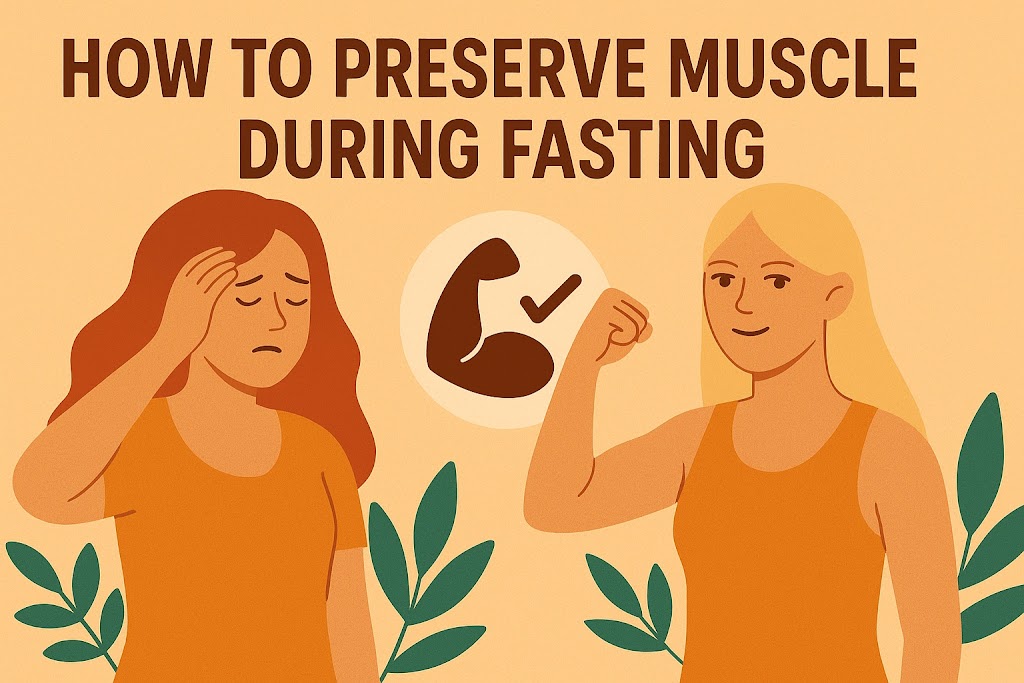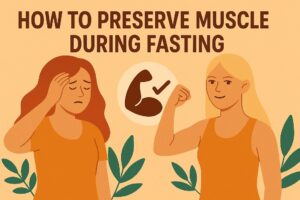Muscle Loss During Fasting: How to Protect Lean Mass Without Breaking Your Fast
Intermittent fasting has gained popularity for its fat-burning and longevity benefits—but many people worry about one big downside: losing muscle. And the concern is valid—especially for women over 40 who are already facing hormonal changes that impact muscle preservation.
In this post, we’ll break down:
- How fasting affects muscle tissue
- Whether extended fasts lead to muscle loss
- What you can do to preserve lean mass—without sabotaging your fast
This post is part of our Extended Fasting Series. If you’re struggling with other challenges during long fasts, check out:
- Troubleshooting Your Extended Fast: Real Fixes for Sleep, Digestion & Energy Crashes
- Fasting in Perimenopause: What Women Over 40 Should Know
Does Fasting Cause Muscle Loss?
The short answer is: not if done correctly. In fact, short-term fasts (12 to 48 hours) are muscle-sparing thanks to a hormone called human growth hormone (HGH), which increases significantly during fasting. HGH supports fat metabolism while preserving lean muscle tissue.
However, if you’re fasting for long periods (3+ days) without proper preparation or recovery, or if you’re underweight or protein-depleted, you can start breaking down muscle.
Fasting vs Starvation: The Difference
In a well-supported fast, the body uses fat for fuel. But in starvation, when nutrients are depleted and the body is under extreme stress, it may begin to use muscle protein for gluconeogenesis (glucose production).
Key Point:
Fasting burns fat, not muscle—unless you’re doing it wrong.
5 Key Ways to Prevent Muscle Loss During Fasting
1. Prioritize Protein Intake Before and After Your Fast
Muscle preservation starts before the fast. Make sure your last meals before a 24–72 hour fast are rich in:
- Complete protein (eggs, fish, poultry, or high-quality plant sources)
- Essential amino acids
- Micronutrients (magnesium, zinc, B-vitamins)
After fasting, break your fast gently with protein and healthy fats to re-stimulate muscle synthesis.
Recommended:
2. Use Essential Amino Acids (EAA) During Your Fast
If you’re doing a long fast and are highly active or older, you can supplement with EAAs to reduce muscle breakdown. EAAs can be used during fasts without spiking insulin significantly.
Try: Fasting-safe EAA powders with no added sugars or calories.
3. Add Light Resistance Training
Contrary to popular belief, working out during a fast can preserve muscle. Low-intensity resistance training signals your body to retain muscle—even if you’re not eating.
Keep sessions short and simple:
- Bodyweight squats
- Pushups
- Resistance band rows or curls
View affordable resistance band kits for home use.
4. Avoid Over-Fasting if You’re Already Lean
If your body fat is already low (especially for women), longer fasts can lead to muscle breakdown sooner. In this case, fast shorter and refeed more often.
Women over 40 should avoid long-term OMAD or extended water fasting back-to-back unless supervised.
5. Support Hormonal Balance
Estrogen and progesterone both impact muscle retention, recovery, and energy. Perimenopausal women need to be more intentional about recovery, lifting, and protein intake.
Magnesium glycinate and ashwagandha can help regulate cortisol and reduce catabolic (muscle-wasting) stress.
Signs You May Be Losing Muscle
- Weight loss but arms/legs look smaller and weaker
- Lower strength or stamina
- Soreness or fatigue after minor effort
- Slow recovery after workouts or fasts
If you’re seeing these symptoms, reassess your fasting routine, especially if you’re doing frequent prolonged fasts or OMAD-style eating.
Fasting Methods That Are Muscle-Friendly
| Fasting Type | Muscle Safety | Best For |
|---|---|---|
| 16:8 | Safe for daily use with proper meals | Most people, especially women over 40 |
| 20:4 | Higher muscle loss risk if not eating enough protein | Body recomposition; advanced users |
| 24–72hr fast | Minimal loss with good prep/recovery + light training | Fat loss, metabolic reset |
| OMAD daily | Higher risk for under-eating protein | Not ideal for women over 40 |
Post-Fast Recovery for Lean Mass
Breaking your fast properly supports protein synthesis and helps avoid muscle breakdown:
- Start with bone broth or lean protein
- Add small amounts of healthy fat and carbs
- Hydrate and get 7–8 hours of sleep
Electrolyte powders are helpful for rehydration and muscle repair post-fast.
Final Thoughts
Fasting doesn’t have to come at the cost of muscle—especially when done intelligently. By prioritizing protein, listening to your body, and supporting your hormones, you can enjoy the benefits of fasting while preserving strength and stamina.
💡 Share this post with someone who wants to try intermittent fasting!
And don’t forget to tag @TheResetRitual if you’re sharing your journey 🧘♀️💬
Disclaimer: This article is for informational purposes only and is not medical advice. Always consult with your healthcare provider before making changes to your diet, fasting routine, or lifestyle. This post may contain affiliate links. As an Amazon Associate, I earn from qualifying purchases.


